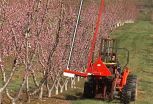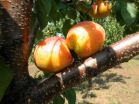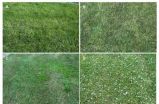(Press-News.org) GETTYSBURG, PA – Peach producers have traditionally relied heavily on hand thinning, a necessary but costly and labor-intensive field practice. Impacted by increasing labor costs and a limited workforce, peach and other stone fruit growers are turning to mechanical methods such as string thinners to minimize the need for hand thinning. A new ''hybrid'' string thinner prototype showed promising results when it was evaluated in four U.S. growing regions; the trials resulted in significant labor savings and increased peach size.
According to Pennsylvania State University's T. Auxt Baugher, corresponding author for the research report published in HortTechnology, the goal of the study was to determine if a new string thinner prototype designed to thin vase or angled tree canopies could be adapted for varying orchard systems. Trials with the hybrid mechanical blossom string thinner were performed in California, South Carolina, Washington, and Pennsylvania commercial orchards. The prototype used in the experiments was a hybrid of a vertical rotating string thinner designed to remove apple blossoms in organic orchards and a horizontal prototype evaluated in previous peach thinning trials. The researchers evaluated blossom removal rate, fruit set, labor required for follow-up hand thinning, fruit size distribution at harvest, yield, and economic impact. Additional information was collected using case study interviews of growers and orchard managers.
String thinner trials demonstrated reduced labor costs compared with hand-thinned controls, and increased crop value due to a larger distribution of fruit in marketable and higher market value sizes. Blossom removal ranged from 17-56%, hand thinning requirement was reduced by 19-100%, and fruit yield and size distribution improved in at least one string-thinning treatment per experiment. Notably, the savings in hand-thinning requirement and increases in fruit size distribution increased the economic value of the peach crops beyond that of hand thinning alone, with gross income ranging from $4,267-9,127 per acre in processing plantings and $5,097-12,288 per acre in fresh fruit plantings.
Net positive economic impact from mechanical thinning (realized economic savings beyond hand thinning alone) ranged from $236-1,490 per acre and $264-934 per acre for processing and fresh fruit plantings respectively, with the exception of one treatment in which the economic impact was negative. According to Baugher, "increased fruit size had a greater positive impact for fresh market producers, while labor savings and yield increases (due to larger fruit size) were of greater importance for canning peach growers."
In another aspect of the report—case study interviews with 11 Pennsylvania growers and orchard managers who had used the prototype—interviewees suggested that commercial adoption of mechanical string thinning technology would have positive impacts on the work place. All case study participants reported that the technique made crop load management more efficient and reduced follow-up hand-thinning time, while 80% of the growers noted that fruit from thinned trees were larger. Growers observed that the string thinner allowed hand thinning of peaches to be completed earlier, allowing more timely work in other crops. They also found that employees were satisfied with mechanical thinning, as it saved them time and minimized ladder use, and that the seasonal distribution of labor-intensive work was improved.
The string thinner prototype developed for the study has been commercialized and will be manufactured in both North America and Germany.
INFORMATION:
The complete study and abstract are available on the ASHS HortTechnology electronic journal web site: http://horttech.ashspublications.org/cgi/content/abstract/20/2/409
Founded in 1903, the American Society for Horticultural Science (ASHS) is the largest organization dedicated to advancing all facets of horticultural research, education, and application. More information at ashs.org
Hybrid string blossom thinner tested in peach orchards
Prototype increases crop value, reduces labor costs in multi-state trials
2010-12-30
ELSE PRESS RELEASES FROM THIS DATE:
Genetic relationship between Hungarian and Turkish apricots confirmed
2010-12-30
BUDAPEST, HUNGARY – Apricots are important to Turkey, the country where more apricot crops are grown and exported than anywhere in the world. Looking to unlock the mystery of apricots' origins and increase crop production, scientists are studying the genetic relationship between apricot varieties. New research from a team of Hungarian and Turkish scientists has confirmed the genetic link between Turkish and Hungarian apricot cultivars, yielding information that provides valuable data for apricot growers and breeders.
It is widely believed that apricots originated in China, ...
Turfgrass fertility, pesticide programs compared
2010-12-30
WEST LAFAYETTE, IN – Traditional turfgrass management programs rely heavily on the use of synthetic pesticides and fertilizers. In response to increased public scrutiny and legislation, organic and biological alternatives are becoming more accepted, but research indicates that these alternatives have not been widely adopted by either homeowners or the lawn care industry. Results of a new study that compared common but disparate turfgrass management approaches may help lawn care professionals to evaluate, market, and implement alternative management programs.
Purdue University ...
Indoor plant intervention: New answers for health care design?
2010-12-30
NORWAY – Could a plant "intervention" improve the well-being of patients in a difficult rehab process? Scientists from the Norwegian University of Life Sciences and Sweden's Uppsala University investigated this question in a recent study of 436 coronary and pulmonary patients at a Norwegian rehabilitation center. The results were published in HortScience. Ruth Kjærsti Raanaas, Grete Grindal Patil, and Terry Hartig studied the effects of an indoor plant intervention during a 2-year study conducted at the Røros Rehabilitation Center. The experiment showed that patients' overall ...
Children in areas with few pediatricians at higher risk for serious appendix ruptures
2010-12-30
Children who live in areas with fewer pediatricians are more likely to suffer life-threatening ruptures of the appendix than those in areas with more pediatricians, even when accounting for other factors such as the number of hospitals, imaging technology, insurance coverage and the number of surgeons in an area, according to a study from the Johns Hopkins Children's Center.
The study's findings, based on an analysis of nearly 250,000 hospital records of children with appendicitis, are published online in the December issue of JAMA-Archives of Surgery.
"Our analysis ...
Protein involved in cystic fibrosis also plays role in emphysema, chronic lung disease
2010-12-30
A team of Johns Hopkins Children's Center researchers has discovered that a protein involved in cystic fibrosis (CF) also regulates inflammation and cell death in emphysema and may be responsible for other chronic lung diseases.
The findings, published online in the December issue of The Journal of Immunology, pave the way toward new treatments to prevent lung damage caused by infections or cigarette smoke in emphysema.
The protein, called CFTR (cystic fibrosis transmembrane conductance regulator), is already well known for its role in transporting chloride in and ...
Coma and general anesthesia demonstrate important similarities
2010-12-30
NEW YORK (Dec. 30, 2010) -- The brain under general anesthesia isn't "asleep" as surgery patients are often told -- it is placed into a state that is a reversible coma, according to three neuroscientists who have published an extensive review of general anesthesia, sleep and coma, in the Dec. 30 issue of the New England Journal of Medicine. This insight and others reported in their review article could eventually lead to new approaches to general anesthesia and improved diagnosis and treatment for sleep abnormalities and emergence from coma.
The researchers explain that ...
Longevinex exhibits L-shaped safety curve for first time in resveratrol biology
2010-12-30
Las Vegas, Nevada (Dec. 30, 2010) – It was Paracelsus, the Renaissance physician (1493-1541 A.D.) who first said "the dose makes the poison." So, you can drink too much wine, or ingest too much resveratrol, but in an unprecedented study, heart researchers report they couldn't find a toxic dose for Longevinex®, a resveratrol-based dietary supplement.
Investigators previously reported that six or more glasses of red wine per day actually increase the risk, whereas 3-5 glasses per day optimally reduce risk for cardiac death. This is the well-known J-shaped risk curve ...
Merrill DataSite Captures Repeat Industry Honors as "Product/Service of the Year"
2010-12-30
Merrill Corporation (www.merrillcorp.com), a leading provider of technology-enabled services, is pleased to announce that Merrill DataSite was named "Product/Service of the Year" for the second year in a row at the at the 9th Annual M&A Awards, presented by the M&A Advisor. The awards gala, which honors professionals in the mergers and acquisition industry, took place at the New York Athletic Club on Dec. 14, 2010.
The M&A Awards honored deal-teams, dealmakers, and firms whose activities set the standard for the industry. This year, 243 finalists in 47 categories were ...
Indie Perfumery Introduces a New Fragrance for Women: "Snaub Wedding Day"
2010-12-30
A perfume specifically designed just for your wedding day? Why hasn't anyone thought of that before?
Perfume is one part of the wedding many brides give only a passing thought. It's not uncommon for a bride to spend thousands of dollars on just a dress. Another small fortune for a cake, a dj, a venue and catering. But why grab the same department store perfume or a perfume named after a celebrity when you can wear the perfume created just for brides?
Snaub Worldwide (pronounced just like Snob) has launched a new perfume called Snaub Wedding Day.
The perfect fragrance ...
LCSW Yochanan Berkowitz Analyzes Holiday Depression
2010-12-30
Analyzing data collected from his own practice and from the National Mental Health Association, Yochanan Berkowitz has discovered that holiday depression is likely more common than most people realize. Common reasons for holiday depression are fatigue, family tensions and financial limitations, reports Yochanan Berkowitz. Another major cause of the holiday blues, he adds, is unrealistically high expectations.
According to Yochanan Berkowitz, all holidays bring a kind of insistence with them. This is particularly true of the winter holidays, which occur amidst short ...
LAST 30 PRESS RELEASES:
Bacteria resisting viral infection can still sink carbon to ocean floor
Younger biological age may increase depression risk in older women during COVID-19
Bharat Innovates 2026 National Basecamp Showcases India’s Most Promising Deep-Tech Ventures
Here’s what determines whether your income level rises or falls
SCIE indexation achievement: Celebrate with Space: Science & Technology
Children’s Hospital Colorado performs region’s first pediatric heart and liver dual organ transplant
Australian team discover why quantum computers have memory problems over time
What determines the fate of a T cell?
Candida auris: genetic process revealed which could be treatment target for deadly fungal disease
Groundbreaking discovery turns household plastic recycling into anti-cancer medication
Blocking a key inflammatory pathway improves liver structure and vascular function in cirrhosis, study finds
Continuous spread: Raccoon roundworm detected in nine European countries
HKUST Engineering researchers developed a novel photodetector to enhance the performance of on-chip light monitoring
Strategic river sensors could have forewarned of Texas Camp flood disaster
Drone sampling of whale breath reveals first evidence of potentially deadly virus in Arctic
Roman soldiers defending Hadrian’s Wall infected by parasites, study finds
Pinochet’s prisoners were tormented with music but still found solace in it, a new book reveals
Fertility remains high in rural Tanzania despite access to family planning
AI-assisted device can improve autism care access
Kinetic careers
Uncovering how parasitic plants avoid attacking themselves to improve crop resistance
Nanoparticle vaccine strategy could protect against Ebola and other deadly filoviruses
Study finds brain care score can predict risk of stroke across racial groups
Key lung immune cells can intensify allergic reactions
Do hormones explain why women experience more gut pain?
New materials conduct ions in solids as easily as in liquids
Breakthrough of the Year: Renewable energy begins to eclipse fossil fuel-based sources
LLM use is reshaping scientific enterprise by increasing output, reducing quality and more
Introducing LightGen, a chip for ultra-fast, ultra-efficient generative AI
Astronomers see fireworks from violent collisions around nearby star
[Press-News.org] Hybrid string blossom thinner tested in peach orchardsPrototype increases crop value, reduces labor costs in multi-state trials





